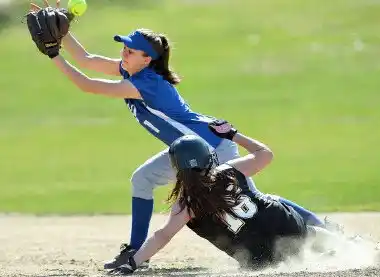Everyone marvels at the third base player with the quick, gutty reaction time on those pulled smashes. They extol the virtue of the first base player that never lets anything get by her – how she makes all the infielders look good. And, of course, all eyes (and Scouts) are glued to that spectacular range and cannon of an arm. But back in pre-high school youth ball we all knew that we “hid” our misfits in right field and second base.
Now, of course, the higher the level of ball encountered, the better all position players will, and must, be. However, I think many are guilty of still carrying the old attitude into higher fastpitch softball responsibilities. This can be disastrous.

It’s true. The second baseman does not have to have the “big” arm, but that’s all. She must have the quick, accurate arm, and it must be capable of going instantaneously in one of two opposing directions……1st and home, or 2nd and 3rd. She must also make all the tough ground ball plays that SS must take – the straight-up 2nd or 3rd bounce ball; the go-to-right stay-low underhand to 2B or the anchor with right-foot, and back-throw-to-first ball; the charge, short-hop and off-foot throw; and the go short left and underhand, or go deep left and throw back off-body to 1st play. These all take a gifted and versatile athlete.
Furthermore, the second baseman is the only infield player that truly must play proficiently two base positions…second base and first base. She will spend as much time handling the latter as the former….perhaps more. Not only must she make the usual tags and the force and turn play at 2B, but she can, and should, depending on the caliber of other players, take some stealing throws at 2B.
At 1B…she must take the quick, hard, and short bunt-play throw, and make the bang-bang, tangle-up tag play on the catcher’s pick-off throw. This is in addition to the routine stretch play on the SS to 1B double play with the 1B person up.
Thus besides requiring probably more unique technique skills than any other position, second bases necessarily requires a great deal of thinking or decision making.
Besides the normal where-to-play-the-ball decisions, second base has more decisions as to which direction to go than anyone. A good example of this is what I feel is constantly the toughest decision/reaction situation in fastpitch softball…the standard (almost every inning) situation…a runner on 1st and less than two outs.
In this situation, if every play was known to be a bunt, covering 1st would be simple. Or, if every play were known to be a swing-away, you would simply play 2B or field the ball. But this is hardly ever the case.
The second base player must not only be physically ready to cover 2B for the double-play attempt (or steal cover) or 1B on the bunt….but she must make an instantaneous decision at exactly the right moment as to which it is to be. This scenario is the epitome of fastpitch softball.
Fastpitch is a short-quarters, instant decision, quick reaction, exaction techniques, accurate execution, and under control sport. No position like second base, or play like the foregoing, more appropriately represents it.
Of course, good offensive strategies do not make the second base job in this most difficult of situations any easier. Strategies such as fake bunt and slap, fake hit and bunt, run-up slap or bunt, etc…or even the unplanned swing-away and mis-hit for a dribbler can drive second base players bananas. (And, of course, that’s the offense’s idea in fastpitch softball).
Making this situation tougher yet is that it is a key turning point in every game. Reflect for a moment. Except for extra base hits, every runner-on defensive situation starts with the runner on 1B, and except for having obtained 2 outs already the toughest play thus is usually the first play.
Now, if played right, you get a double play, or at the least, an out. This usually kills an inning. Muff this situation, however, and chances are good that a run (or more) will result. This situation is the routine turning point. And second base is this point’s key.
So now we have second base with both more techniques to master and decisions to make than most and also a great deal of pressure. Indeed, second base is a key position…possibly a case for MVP.
This proposition is not to suggest more accolades for the player. More rather to suggest that maybe we don’t spend enough time teaching and practicing the techniques and thought process that this position warrants.
This could be wrong of course, but if observations of infield practices are any indication, this position is not getting its due. More than not, one can watch as double plays are called for with the corners back….everyone expecting it. This is, of course, unreal and practices only the specific, expected field-and-throw technique. It does not teach either the decision making process or the quick response techniques necessary. Therefore, while the former techniques may be taught and practiced, the latter are apparently not. This indicates that maybe more needs to be taught about this key position…or perhaps we just need to indeed treat second base like she is ….an MVP.